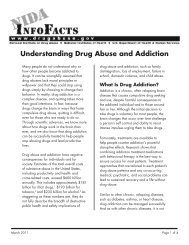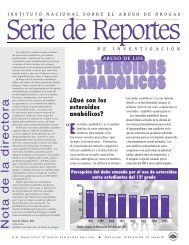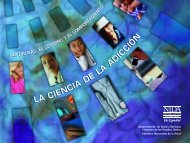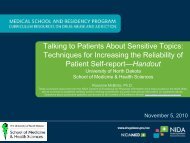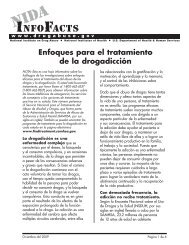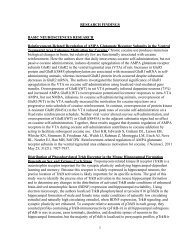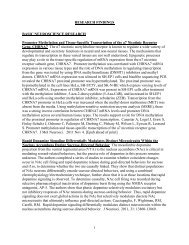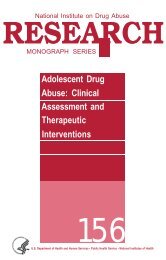Neurotransmission Fact Sheet
Neurotransmission Fact Sheet
Neurotransmission Fact Sheet
- No tags were found...
You also want an ePaper? Increase the reach of your titles
YUMPU automatically turns print PDFs into web optimized ePapers that Google loves.
Brain Parts <strong>Fact</strong> <strong>Sheet</strong>Cerebral Cortex:• Largest part of the brain• Most highly developed part of the brain• Controls thinking, perceiving, and understanding language• Corpus callosum connects the two hemispheresHemispheres of the cerebral cortex:Left Hemisphere• Controls the right side of the body• Responsible for mathematical ability,problem solving, language, anddecision-makingRight Hemisphere• Controls the left side of the body• Responsible for artistic expression andunderstanding relationships in spaceLobes of the cerebral cortex:Parietal Lobe• Located below the crown of the head• Processes sensory information from the whole body(information about pain, touch, and pressure)Frontal Lobe• Located right behind the forehead• Responsible for initiating and coordinatingmotor movements and higher cognitiveskills like problem solving and thinkingOccipital Lobe• Located in the back of the brain, againstthe skull• Processes all the visual informationcoming into the brainTemporal Lobe• Located behind the temples and justabove the ears• In charge of making sense of theinformation you hear• Integrates information from varioussenses, such as smell and visionHypothalamus:• Controls body temperature, hunger, and thirstCerebellum:• Controls posture, movement, and the sense of balance*not visible by cross-sectionBrain Stem:• Brain’s most primitive part• Controls simple reflexes, such as coughing, sneezing, and digestion• Two main parts—pons and medulla• Pons contains the fibers that connect the cerebral cortex withthe cerebellum and spinal cord; also controls sleeping,awakening, and dreaming• Medulla controls heart rate, respiration, and blood pressure;connects the brain to the spinal cordLimbic System: two main parts—hippocampus and amygdala• Hippocampus controls learning and memory• Amygdala plays an important role in emotional behaviorTeacher copy: Module 1



